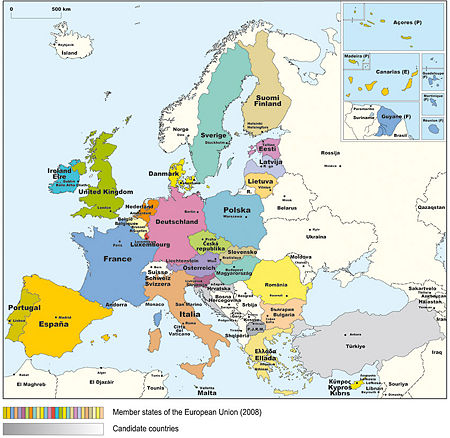European Union
The European Union (EU) is a political and economic entity consisting of 27 member states. In legal form, it is a complex hybrid structure with elements of federalism (such as the European Court of Justice and the European Parliament), intergovernmentalism (the Council of Ministers) and some characteristics of an international organsation (the European Commission represents the Union in certain international negotiations). It has grown from the six founding member states of the European Economic Community in 1957, through many accessions of new members — especially, in recent years, much of the former European Communist bloc.
Overview
Rationale
Determined to lay the foundations of an ever closer union among the peoples of Europe, ... we are agreed ...
|
Perceptions of the rationale for the European Union have differed among its participants. Its founders saw it as the foundation of a union of the peoples of Europe (see box), but some of its later participants have seen it solely as a union of the sovereign nations of Europe. Its member countries have not since relinquished control over their defence and international policies, and the progress toward union that has been achieved has been predominately in the sphere of economic policy. In that sphere, however, every step in the Union's evolution has involved a further partial surrender of its members' national sovereignty. The launch in 1988 of the Economic and Monetary Union[1] was a step further than some of its members were willing to take at that time. The further surrender of national sovereignty by the countries that did take that step included the total relinquishment of control over monetary policy, and submission to agreed limits upon the exercise of fiscal policy. Member countries retained limited discretion over public expenditure and taxation, however, and in that respect the integration of economic policy has so far been incomplete.
The principal advantage of membership to a country has been seen as the unrestricted access that it provides to wider markets for its products. The adoption of a common currency as part of the Economic and Monetary Union was seen as further lowering barriers to those markets by reducing transaction costs and eliminating exchange rate risks. It was generally accepted that there could be offsetting disadvantages arising from loss of control over the domestic economy, but most of the continent's governments judged the balance to be positive. Some have since come to question that judgement because of the unsymmetrical impact of recent demand shocks upon the domestic economies of member countries.
Organisational structure
The principal institutions of the European Union are
- The European Council[2] Heads of State or Government of the Member States, together with its President and the President of the Commission (and the High Representative of the Union for Foreign Affairs and Security Policy if required.)
- The Council of the European Union[3] - the main decision-making body of the EU (ministers of the member states - foreign affairs, finance, social affairs, transport, agriculture, etc.).
- The European Parliament[4] - a directly-elected body that takes legislative decisions on some issues jointly with the Council of Ministers.
- The European Commission[5] - the driving force in proposing legislation (to Parliament and the Council), administering and implementing EU policies, enforcing EU law (jointly with the Court of Justice) and negotiating in the international arena.
- The European Central Bank[6] - conductsthe EUs monetary policy.
Policies
History
The devastating wars of the first half of the 20th century convinced European politicians that some form of cooperation was needed, so that future wars could be avoided. One of the main proponents was Robert Schuman, foreign minister of France. Schuman proposed a European federation, and the first step would be the integration of the coal and steel industries of Western Europe. This led to the creation of the European Coal and Steel Community, formed in 1951. The original six members were France, West Germany, Italy, Belgium, Luxembourg, and the Netherlands.
Foundation
The Treaty of Rome (1957) formed the first common European market, the European Economic Community (EEC). The EEC guaranteed "the four freedoms": the free movement of goods, services, capital, and people. In 1967, the Economic Community, the Coal and Steel Community, and the European Atomic Energy Community were merged into the European Community (EC). The EC created a single Commission, a single Council of Ministers, and the European Parliament.
Enlargement
The early 1970s saw the first enlargement of the EC. The United Kingdom, Ireland, and Denmark joined. Norway was also invited into the EC, but the electorate rejected it in a referendum. The EC was further enlarged in the 1980s, when Greece joined in 1981 and Portugal and Spain in 1986. Sweden, Finland, and Austria were admitted into the Union in 1995, but the Norwegians again declined to join.
The next round of expansion came in 2004, when Estonia, Latvia, Lithuania, Poland, the Czech Republic, Hungary, Slovakia, Slovenia, Malta, and Cyprus joined. This was the first time countries in Eastern Europe had joined the EU. In 2007, Romania and Bulgaria also joined the EU.
Maastricht Treaty
The Maastricht Treaty was signed in 1992, and transformed the European Community into the European Union.
Amsterdam Treaty
The Amsterdam Treaty of 1997 amended the Maastricht Treaty. It gave more power to the European Parliament,
The Eurozone
In 1999, eleven countries adopted the Euro as their common currency. Greece and Slovenia have since joined the Eurozone.
